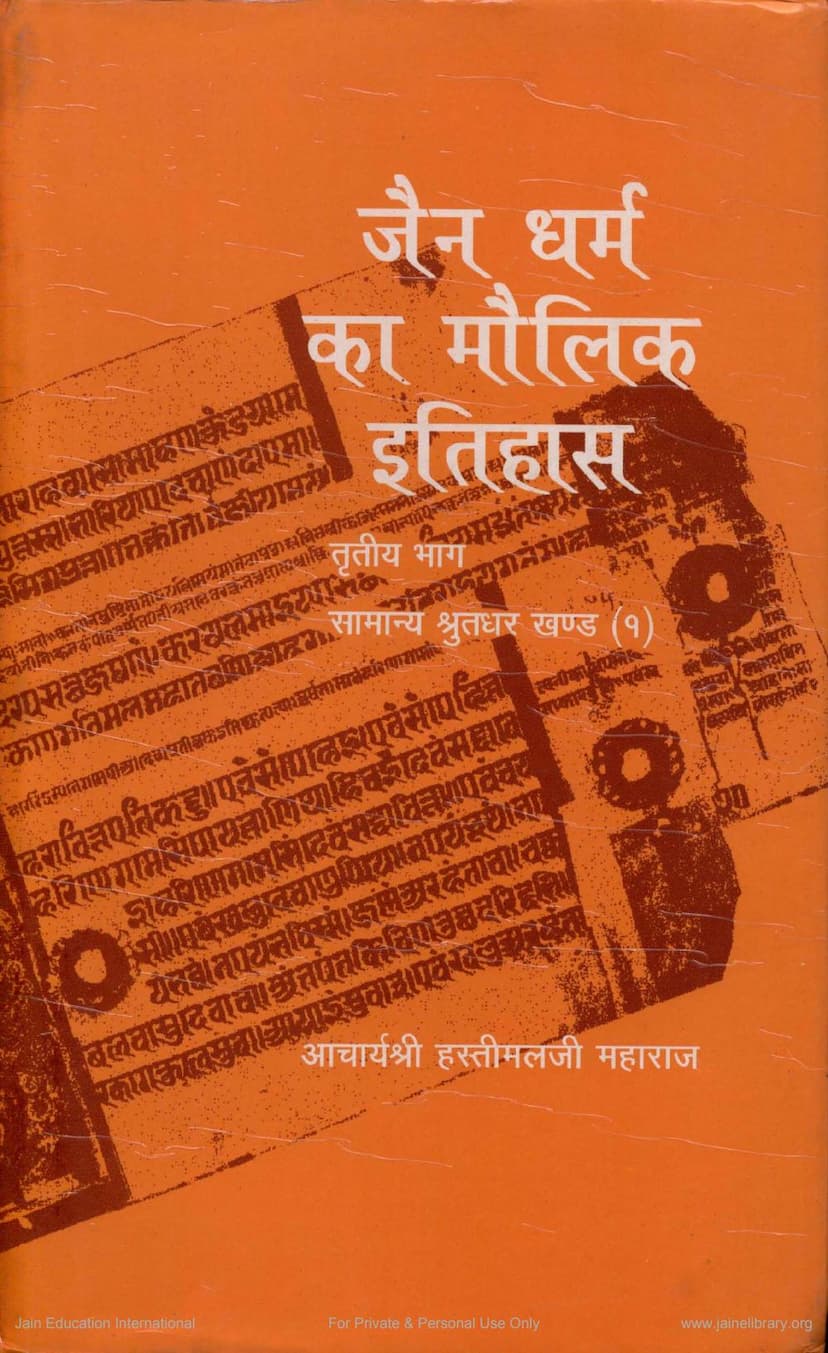Jain Dharma Ka Maulik Itihas Part 3
Added to library: September 2, 2025

Summary
Here is a comprehensive summary of the Jain text "Jain Dharma ka Maulik Itihas Part 3" by Hastimal Maharaj, based on the provided catalog link and page content:
Book Title: Jain Dharma ka Maulik Itihas Part 3 (Original History of Jainism, Part 3) Author: Hastimal Maharaj Publisher: Jain Itihas Samiti Jaipur Catalog Link: https://jainqq.org/explore/002073/1
This third volume of the "Original History of Jainism" series, under the guidance of Acharya Shri Hastimalji Maharaj, delves into a crucial and often complex period of Jain history. It focuses on the "Samanya Shrutdhar Khand 1" (General Shrutdhar Section, Volume 1), covering the period from Veer Nirvana Samvat 1001 to 1500.
Key Features and Content Highlights:
- Chronological and Factual Detail: The book provides a factual account of significant religious, social, and political events during the period of Veer Nirvana Samvat 1001 to 1500.
- Authentic History of Jain Acharya Lineage: It presents a chronological and authentic history of the lineage of Jain religious leaders (Acharyas).
- Analysis of Decline and Deviations: A significant portion of the research explores the gradual decline of strict asceticism (Shund Shramanaachaar) and the emergence and development of corrupted or deviated traditions within Jainism.
- Biographies of Contemporary Acharyas and Dynasties: The work systematically presents the historical accounts of contemporary religious leaders and ruling dynasties.
- Resolution of Historical Complexities: It aims to resolve complex issues in Jain history with evidence, rectify fundamental misconceptions, and shed new light on obscure aspects of overall Indian history.
- Contributions of Women in Jainism: A significant and novel discovery highlighted is the unparalleled contribution of women in the Jain tradition, serving as heads of the monastic community (Sangh Pramukha), Acharyas, ascetics (Shramani), and devoted followers (Shramanoopsika).
- Engaging Presentation: The book is written in a lucid, understandable, and flowing style, making a potentially dense subject like history accessible and enjoyable.
The Table of Contents reveals the detailed scope of the volume:
The book is structured into several key chapters, indicating a deep dive into specific historical periods and traditions:
- An Overview: Starting with a general introduction and focusing on facts related to the post-Devarddhikshamasraman period and the true nature of the Shramana tradition from Veer Nirvana to the time of Devarddhikshamasraman.
- The Fruit of Non-Violence: Discusses the rewards of not causing harm and not allowing harm to be caused.
- Changes in Shramanacharya: Details the original nature of Dharma and Shramanacharya and the historical mention of changes introduced by the Chaityavasi tradition, highlighting the vast difference between the original and the altered forms.
- Background of Corruptions: Explains the background and development of corruptions within the later monastic orders, the emergence, ascendancy, and monopolistic dominance of the Chaityavasi tradition, and the consequences of their influence.
- The Bhattaraka Tradition: This is a major focus, exploring the three forms of the Bhattaraka tradition, their timelines, the first form, the second form (including a list of Acharyas from the Pattavali of Nandisangha), the third form, its background, its emergence in difficult circumstances, the consecration of the first Bhattaraka, the establishment of Bhattaraka Piths, the shrine of Shravanabelgola, the era of Acharya Maghanandi, and the confluence of various traditions influenced by the Bhattaraka tradition, including the influence of the Yapaniya tradition and the presence of female Sadhvis in the Bhattaraka position.
- The Yapaniya Tradition: Discusses its origin, timeline, beliefs, significant transformations, ancient centers, and patron dynasties.
- Dynasties Supporting the Spread of Dravya Traditions: Covers the contributions of the Ganga, Kadamba, Rashtrakuta, Ratta, and Hoysala dynasties.
- Historical Attempts at Synthesis: Examines an attempt at synthesis and its eventual failure.
- Jain Shraman and Shramani: Details their traditional attire, religious practices, and conduct according to scriptures.
- Acharya Tradition from Veer Nirvana 1000 AD onwards: This section delves into the lineage of Acharyas, including the "Samanya Shrutdhar Kaal" (General Shrutdhar Period) and provides biographical details of various influential Acharyas and scholars, tracing the lineage and their contributions.
Key Themes and Scholarly Contributions:
The book appears to be a meticulous historical research effort, drawing from various sources, including ancient manuscripts, inscriptions, and literary works. It addresses critical aspects of Jain history, such as:
- The Evolution and Deviation of Practices: Tracing the modifications and deviations from the original strict asceticism prescribed by Lord Mahavir, particularly highlighting the rise of traditions like the Chaityavasi and Bhattaraka lineages.
- The Role of Patronage: Emphasizing the significant role played by various ruling dynasties in the patronage and spread of Jainism and its different traditions.
- Debates and Controversies: The text likely engages with historical debates and attempts to clarify points of confusion in Jain historiography.
- Detailed Chronology: The focus on specific periods like Veer Nirvana Samvat 1001-1500 suggests a detailed chronological reconstruction of events.
- Holistic Historical Approach: The intention to cover religious, social, and political aspects reflects a comprehensive approach to history.
In essence, this volume is a scholarly attempt to provide an authentic and detailed history of a specific, transformative period in Jainism, focusing on the evolution of its traditions, the key figures who shaped them, and the socio-political backdrop against which these developments occurred. It appears to be a valuable resource for anyone seeking a deep understanding of Jain history beyond the early foundational periods.